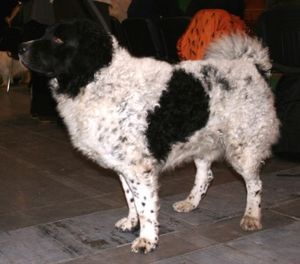 |
| Vital Statistics: |
| Place of Origin: Canada |
| Group: Sporting, Gun dog |
| Height: males 18-21 in., females 17-20 in. |
| Weight: males 45-51 lbs., females 35-50 lbs. |
| Life span: 12-14 yrs. |
| Trainability: moderate/high |
| Good with children: yes |
| Good with other pets: with high prey drive, early socialization necessary |
What is the origin of the Nova Scotia Duck Tolling Retriever?
This smallest of the retrievers was developed in Nova Scotia in the early 19th century. The Toller’s origins may include the Golden Retriever, Irish Setter, Cocker Spaniel or the Kooiker Hound (a Dutch spaniel-type).
What does the Nova Scotia Duck Tolling Retriever look like?
Males are 18-21 inches tall and weigh 45-51 lbs. Females are 17-20 inches tall and weigh 35-50 lbs. The head is foxlike in appearance. Ears are triangular and set back. The tail is feathered and carried perkily. the coat is double, water-repellent, medium length and medium soft. The undercoat is dense. Color is any shade of red from golden to a dark copper sometimes with white markings. Coat should be brushed at least once a week. Hairs on the feet amd behind the ears can be trimmed once a month.
What is the temperament of the Nova Scotia Duck Tolling Retriever?
Tollers are very intelligent and enthusiastic workers, easy to train. They do need early positive training and socialization beginning with puppy classes. In this way the Toller will learn to behave properly, especially with children and other pets although they may view other pets as prey if not properly socialized. Affectionate with the family, they may be reserved with strangers. Tollers need lots of vigorous exercise with an energetic family.
What is the Nova Scotia Duck Tolling Retriever used for?
Tollers as the name implies are used for tolling (luring) and retrieving ducks. They perform very well in agility and obedience trials. Tollers love to swim and hike and have fun with the family.
Possible Health Issues
Hip dysplasia, patellar luxation, progressive retinal atrophy, Addison’s Disease, hypothyroidism.
- American Cocker Spaniel
- Boykin Spaniel
- Bracco Italiano
- Brittany Spaniel
- Chesapeake Bay Retriever
- Clumber Spaniel
- Curly-coated Retriever
- Dalmatian
- English Setter
- English Springer Spaniel
- German Shorthaired Pointer
- Gordon Setter
- Irish Red & White Setter
- Japanese Akita Inu
- Kai Ken Dog
- Karelian Bear Dog
- Labrador Retriever
- Lagotto Romagnolo
- Llewellyn Setter
- Mountain Cur
- Picardy Spaniel
- Pudelpointer
- Russian Spaniel
- Spinone Italiano
- Vizsla
- Weimaraner
- Welsh Springer Spaniel
- Welsh Terrier
- Wetterhoun
- Wirehaired Pointing Griffon
- Wirehaired Vizsla
- American Cocker Spaniel
- Barbet
- Boulet Griffon
- Boykin Spaniel
- Bull Terrier
- Clumber Spaniel
- Curly-coated Retriever
- Dalmatian
- English Cocker Spaniel
- English Setter
- English Springer Spaniel
- Flat-coated Retriever
- German Shorthaired Pointer
- Golden Retriever
- Gordon Setter
- Harrier
- Irish Setter
- Irish Water Spaniel
- Kishu Inu
- Kooiker Hound (Kooikerhondje)
- Labrador Retriever
- Lagotto Romagnolo
- Landseer
- Mountain Cur
- Otterhound
- Picardy Spaniel
- Poodle
- Pudelpointer
- Redbone Coonhound
- Redtick Coonhound
- Rhodesian Ridgeback
- Spinone Italiano
- Stabyhoun
- Sussex Spaniel
- Telomian
- Treeing Tennessee Brindle
- Vizsla
- Weimaraner
- Welsh Springer Spaniel
- Wirehaired Pointing Griffon
- Wirehaired Styrian Mountain Hound
- Wirehaired Vizsla



